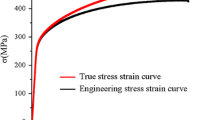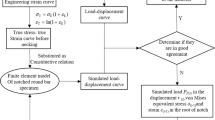Abstract
Failure simulation of 7075-T6 Al alloy is very important due to its relatively low ductility compared to conventional steel. A hybrid numerical-experimental method was developed to determine plastic strains at fracture as a function of triaxiality. The uniaxial tension tests were performed by using the specimens including pure shear, 45° shear, smooth, R5 notch and R15 notch. The fracture locus was established by calibrating the parameters of the Hosford-Coulomb fracture model and was implemented into the GISSMO damage model. The results showed that the predicted force-displacement data were in good agreement with the experimental results. The results of the mesh dependence showed that the mesh size in the range of 0.5–5 mm did not have much influence on the damage results. To assess the accuracy of the damage model, three-point bending tests of the anti-collision beam were performed. The calibrated GISSMO damage model could accurately predict the load-displacement data.
Similar content being viewed by others
Abbreviations
- D :
-
Damage parameter
- ΔD :
-
Damage parameter increment
- ε f (η):
-
The failure plastic strain is a function of the triaxiality
- Δε pl :
-
Equivalent plastic strain increment
- n :
-
Damage exponent
- ε f :
-
Failure plastic strain under different stress states
- η :
-
Triaxiality
- F :
-
Instability parameter
- ΔF :
-
Instability parameter increment
- ε crit :
-
Critical plastic strain under different stress triaxialities
- σ :
-
Stress couple damage and without damage
- D crit :
-
Threshold damage
- m :
-
Fading exponent
- f j (θ):
-
Lode angle parameter θ dependent trigonometric functions. i = 1,2,3
- θ :
-
The lode angle parameter
- θ :
-
The lode angle
- σ :
-
The current flow stress
- σ u :
-
The maximum flow stress
- ε :
-
The current plastic strain
- ε u :
-
The plastic strain at the maximum flow stress
- q :
-
The weighting factor
References
J. G. Cowie and F. R. Tuler, Comparison of shear and tensile fracture in high strength aluminum alloys, International Journal of Fracture, 47 (1991) 229–239.
S. Baltic, J. Magnien, H. P. Ganser, T. Antretter and R. Hammer, Coupled damage variable based on fracture locus: modelling and calibration, International Journal of Plasticity, 126 (2020) 102623.
Z. Wei, K. G. Robbersmyr and H. R. Karimi, Data-based modeling and estimation of vehicle crash processes in frontal fixed-barrier crashes, Journal of the Franklin Institute, 354(12) (2017) 4896–4912.
V. Tvergaard and A. Needlemen, Analysis of the cup-cone fracture in a round tensile bar, Acta Metallurgica, 32(1) (1984) 157–169.
A. Needlemen and V. Tvergaard, An analysis of ductile rupture in notched bars, Journal of the Mechanics and Physics of Solids, 32(6) (1984) 461–490.
A. L. Gurson, Continuum theory of ductile rupture by void nucleation and growth: part I-yield criteria and flow rules for porous ductile media, Journal of Engineering Materials and Technology, 99(1) (1977) 2–15.
C. C. Chu and A. Needleman, Void nucleation effects in biaxial stretched sheets, Journal of Engineering Materials and Technology, 102(3) (1980) 249–256.
M. E. Korkmaz and M. Gunay, Confirmation of johnson-cook model parameters for nimonic 80a alloy by finite element method, Journal of Polytechnic, 23(3) (2020) 625–632.
G. Venturato, A. Ghiotti and S. Bruschi, Stress-state dependent formability modelling in hot stamping, Production Engineering, 14(1) (2020) 105–114.
P. Samadian, L. Kortenaar, K. Omer, C. Butcher and M. J. Worswick, Fracture characterization of tailored Usibor (R) 1500-AS and damage modelling based on a coupled-micromechanical-phenomenological strategy, Engineering Fracture Mechanics, 223 (2020) 106785.
D. Y. Kim, Y. Han, S. Shin and H. Yook, Numerical fracture analysis considering forming effect and element size regularization for automotive seat structures, SAE International Journal of Engines, 10(2) (2017) 287–295.
D. Anderson, C. Butcher, N. Pathak and M. J. Worswick, Failure parameter identification and validation for a dual-phase 780 steel sheet, International Journal of Solids and Structures, 124 (2017) 89–107.
Q. Wang, S. Bruschia, A. Ghiottia and Y. Mu, Modelling of fracture occurrence in Ti6Al4V sheets at elevated temperature accounting for anisotropic behaviour, International Journal of Mechanical Sciences, 150 (2019) 471–483.
L. P. Caro, M. Schill, K. Haller, E. L. Odenberger and M. Oldenburg, Damage and fracture during sheet-metal forming of alloy 718, International Journal of Material Forming, 13(1) (2020) 15–28.
S. Basak, S. K. Panda and M. G. Lee, Formability and fracture in deep drawing sheet metals: extended studies for prestrained anisotropic thin sheets, International Journal of Mechanical Sciences, 170 (2020) 105346.
M. Goswami, S. Goyal, A. Kumar, G. A. Harmain and S. K. Albert, Effect of triaxial state of stress on tensile behavior of modified 9Cr-1Mo steel, Journal of Materials Engineering and Performance, 29(3) (2020) 1579–1588.
Y. Bao and T. Wierzbicki, On fracture locus in the equivalent strain and stress triaxiality space, International Journal of Mechanical Sciences, 46(1) (2004) 81–98.
M. Algarni, Y. Bai and Y. Choi, A study of Inconel 718 dependency on stress triaxiality and Lode angle in plastic deformation and ductile fracture, Engineering Fracture Mechanics, 147 (2015) 140–157.
M. Kim and S. Hong, Simulation of shear fracture in sheet metal forming thick plates under triaxial stress states, Journal of Mechanical Science and Technology, 33(9) (2019) 4413–4419.
F. Neukamm, M. Feucht and A. Haufe, Consistent damage modelling in the process chain of forming to crashworthiness simulations, Proceedings of the 7th German LS-DYNA Forum, Bamberg, Germany (2008) 11–20.
F. X. C. Andrade, M. Feucht, A. Haufe and F. Neukamm, An incremental stress state dependent damage model for ductile failure prediction, International Journal of Fracture, 200(1–2) (2016) 127–150.
M. Basaran, S. D. Wölkerling, M. Feucht, F. Neukamm and D. Weichert, A extension of the GISSMO damage model based on Lode angle dependence, Proc. of the 9th German LSDYNA Forum, Bamberg, Germany (2010) 1–15.
D. Mohr, M. Dunand and K. H. Kim, Evaluation of associated and non-associated quadratic plasticity models for advance high strength steel sheets under multi-axial loading, International Journal of Plasticity, 26(7) (2010) 939–956.
D. Mohr and S. J. Marcadet, Micromechanically-motivated phenomenological hosford-coulomb model for predicting ductile fracture initiation at low stress triaxialities, International Journal of Solids and Structures, 67–68 (2015) 40–55.
Y. Ling, Uniaxial true stress-strain after necking, AMP Journal of Technology, 5 (1996) 37–48.
Acknowledgments
This work was supported by “13th five-year” Scientific Research Planning Project of the Education Department of Jilin Province, China (JJKH20180128KJ).
Author information
Authors and Affiliations
Corresponding author
Additional information
Recommended by Editor Hyung Wook Park
Ge Yu is a Lecturer of the Roll Forging Institute, Jilin University, Jilin Province, China. She received her Ph.D. in College of Materials Science and Engineering, Jilin University. Her research interests include metal forming and damage failure simulation.
Rights and permissions
About this article
Cite this article
Zhang, Z., Cui, Y. & Yu, G. Damaged and failure characterization of 7075-T6 Al alloy based on GISSMO model. J Mech Sci Technol 35, 1209–1214 (2021). https://doi.org/10.1007/s12206-021-0234-8
Received:
Revised:
Accepted:
Published:
Issue Date:
DOI: https://doi.org/10.1007/s12206-021-0234-8




